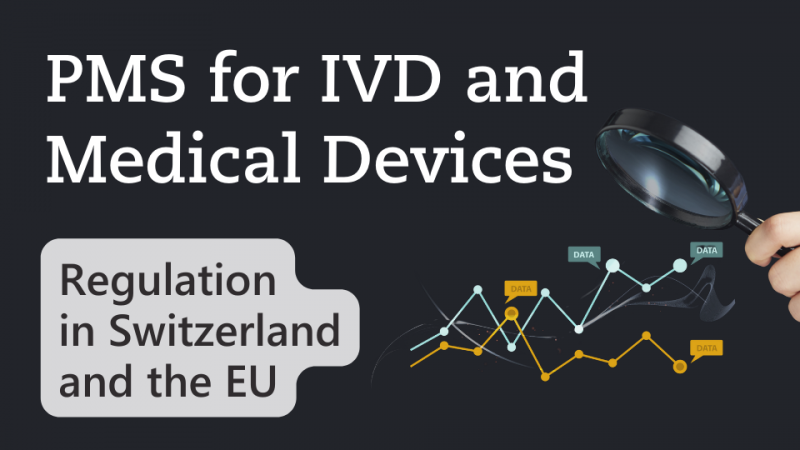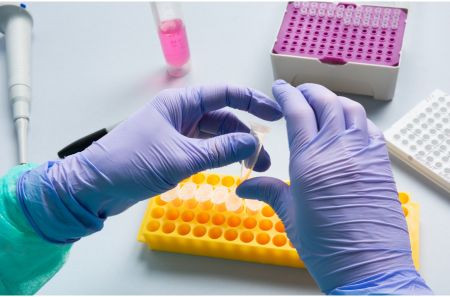Post-Market Surveillance for Medical Devices and IVD - Regulation in Switzerland and a Look at the EU
16/07/2024
Are you responsible for post-market surveillance (PMS) for medical devices or in-vitro diagnostics (IVD) and are unsure which requirements you need to fulfill in Switzerland? Here we will shed light on the importance and implementation of PMS under Swiss legislation, particularly in the context of the regulatory challenges posed by the lack of an updated Mutual Recognition Agreement (MRA) with the European Union (EU).There is currently no update to Chapter 4 (medical devices) of the agreement between the European Community and the Swiss Confederation on mutual recognition in relation to conformity assessments (MRA, SR 0.946.526.81) under the Medical Device Regulation (EU) 2017/745 (MDR) and the In vitro Diagnostic Medical Device Regulation (EU) 2017/746 (IVDR). This poses new regulatory challenges for manufacturers of medical devices and in vitro diagnostics based in Switzerland. European manufacturers must also be prepared for far-reaching consequences if they wish to sell their products on the Swiss market.Back in 2023, we explained the fundamental consequences of the missing update to the MRA between Switzerland and the EU. But what specific impact will this have on certain regulatory requirements, such as for post-market surveillance (PMS)? Join us as we look at how regulatory requirements have evolved and what new challenges manufacturers and other economic operators now face.
 Claudia Möller
Claudia Möller
Regulatory Requirements for Post-Market Surveillance
Post-market surveillance (PMS) is a fundamental requirement for manufacturers of medical devices because it ensures that the safety and performance of products are monitored after their market launch and that necessary measures are introduced in a timely manner. International regulatory authorities, including Swissmedic, therefore require manufacturers to have a comprehensive PMS system as part of product lifecycle reporting in order to achieve these objectives.The regulatory requirements for Switzerland are set out in the Medical Devices Ordinance (MedDO), which came into force on May 26, 2021. One year later, on May 26, 2022, the Ordinance on In Vitro Diagnostic Medical Devices (IvDO) came into force. With the amendment of the MedDO on November 1, 2023, the transition periods were also aligned with the EU requirements.The Swiss regulatory requirements for post-market surveillance are summarized in "Chapter 7: Device Surveillance" in MedDO. The Swiss requirements clearly show a strong orientation on the MDR. In the In Vitro Diagnostics Ordinance (IvDV), we see a similar picture in "Chapter 6: Device Surveillance" with an equally strong alignment on the IVDR. In the following, we will consider these requirements more in depth using the MedDO PMS requirements for medical devices as an example.Like the MDR, Swiss legislation requires a post-market surveillance system as an integral part of the manufacturer's quality management system (QMS). For the modalities of the PMS system, the MedDO refers to Article 83 of the MDR. The reasons for setting up a PMS system in Switzerland and the objectives to be achieved are therefore the same as in the EU.When comparing PMS requirements for medical devices in Switzerland with the European Union, only one difference in the wording needs to be noted. In Switzerland, unlike in the EU, the term "designated body" is used, rather than "Notified Body". However, the designated bodies have the same remit as the Notified Bodies in the European Union.Similarities and Differences
Data Collection and Documentation
As far as documentation is concerned, the MedDO is also based on the MDR: manufacturers must submit a PMS plan detailing the methods and processes for monitoring their products. A post-market surveillance report must be prepared for devices in risk class I and a Periodic Safety Update Report (PSUR) is required for higher classified devices, which contains a comprehensive assessment of the safety and performance data and is updated regularly (at least every two years for class IIa and at least once a year for class IIb and III devices). With regard to content requirements, the MedDO also refers to Annex III of the MDR.At present, there are no published guidelines from Swissmedic on the subject of PMS that provide further specific assistance for the preparation of PMS documents. In contrast, the European Union (EU) already offers a useful guidance in the form of the MDCG 2022-21 to support the preparation of PSURs, which could also be helpful in the Swiss context.The clear orientation towards the MDR is also evident in the other sections of the MedDO on the subject of PMS. Just as in the EU, a safety report, the Summary of Safety and Clinical Performance (SSCP) is required in Switzerland for Class III devices and implantable devices and is simultaneously submitted to the designated body for validation.Due to the similar objectives and requirements for PMS, it is possible to synchronize PMS reporting for the EU and Switzerland and to coordinate PMS activities. In this way, it is possible to reduce the effort involved in preparing the reports. In any case, it is necessary to identify and structure the differences between the data sets (e.g. sales figures, field safety corrective actions) so that the report summarizes appropriate PMS data, analysis and conclusions for each market.Differing Electronic Systems for Vigilance and PMS
Although MedDO and MDR as well as IvDO and IVDR are very similar in terms of content, there is a difference in implementation: the electronic system for vigilance and post-market surveillance. The European Union currently uses some modules of its European Database on Medical Devices (EUDAMED) and is in the process of expanding this electronic system as a database. Switzerland has been working on its own IT system since 2022, the Swiss Database on Medical Devices (swissdamed), which is an electronic system that will be very similar to EUDAMED in terms of its objectives. This database is planned to contain two modules: The Actors Module for the registration of companies and economic operators and the Devices Module for the registration of products. The registration of economic operators should be possible from August 2024; medical devices can likely be registered voluntarily in 2025.Note: After the publication of this article, the swissdamed "Actors Module" went live on August 6, 2024, and is now available for registration.Accordingly, Swiss manufacturers who are active in both markets are also confronted with both databases, which also means additional work for PMS. On the Swiss market, this means:- In accordance with Article 62 of the MedDO, the manufacturer must provide the PSUR directly to the designated body. Furthermore, in the case of devices in risk class III and implantable devices, the designated body checks the report and documents the results in a test report. There is no central platform in Switzerland where the documents are handed over to the respective parties. A direct and close exchange between the parties involved is therefore essential.
- In Switzerland, the manufacturer is responsible for publishing the SSCP. Publication by the Notified Body, as is planned in the EU via EUDAMED, does not exist so far in Switzerland with swissdamed. The manufacturer therefore has an additional burden in Switzerland in suitable publication has to be ensured.
Vigilance and Reporting
Swiss legislation requires the reporting of serious incidents and field safety corrective actions taken in Switzerland. The reporting obligation in accordance with Article 66 MedDO thus corresponds to the requirements of the MDR. The notification is made directly to Swissmedic as the competent authority. The reporting obligation itself as well as exceptions to this obligation, the modalities (e.g. reporting deadlines), the periodic collective reports and the trend reports are also based on the MDR. As Switzerland currently relies on direct communication, electronic and machine-readable reporting is a regulatory requirement in Article 66 of the MedDO. Swissmedic provides manufacturers with the corresponding forms.Reporting System in Hospitals
We would also like to draw attention to Article 67 of the MedDO, which regulates the reporting system of hospitals to Swissmedic. Here, hospitals are required to have an established quality management system (QMS), a competent person (vigilance person) and a retention obligation of at least 15 years. Such or similar requirements cannot be found in EU legislation. Rather, this is an adoption from the previous version of the MedDO from January 1, 2002, which in Article 15 "Reporting of incidents" listed the reporting obligation of healthcare professionals and hospitals in accordance with quality assurance principles.The Implementation of PMS in Practice
The degree of similarity between the Swiss PMS requirements and the MDR PMS requirements presents both opportunities and challenges. Since there are similar requirements for the PMS system and its implementation, it is advisable to consider the relevant MDCG (Medical Device Coordination Group) guidance documents for the EU when preparing the documentation for Switzerland. MDCG 2022-21 on the preparation of the PSUR and MDCG 2019-9 on the SSCP are particularly helpful in this regard. It is also possible to coordinate the preparation of reports between Swiss and European reporting documents and thus harmonize PMS activities.Even if - in theory - there are differences between the scope and use of EUDAMED and swissdamed, in practice most manufacturers in Europe are already familiar with the processes involving direct contact with the authorities and the notified body without database support, as the key modules are not yet available in EUDAMED. Clear procedural structures in the area of vigilance and post-market surveillance are important in order to be able to act correctly and in due time both in Switzerland and in the EU.Conclusion
Even if the Swiss regulations and those of the European Union are very similar at first glance, it is definitely worth looking at the differences in detail. Although many parallels can be drawn in terms of content, the lack of an updated MRA with the EU for medical devices following the introduction of the MDR and IVDR means additional work for manufacturers, designated bodies and other stakeholders. Nevertheless, there is an opportunity to synchronize the PMS datasets and reporting documents due to the requirements of the Swiss legislation and the existing transition periods.We hope that this article has provided you with an initial overview of post-market surveillance in Switzerland. We will be happy to help you efficiently implement post-market surveillance for both Switzerland and the EU. With a well-structured approach, you can keep the necessary effort for your PMS activities as low as possible without sacrificing quality or neglecting your obligations.Feel free to send us a message to find out how we can help you reach your post-market surveillance goals.
Regulatory Affairs & Technical Documentation
Metecon GmbH


